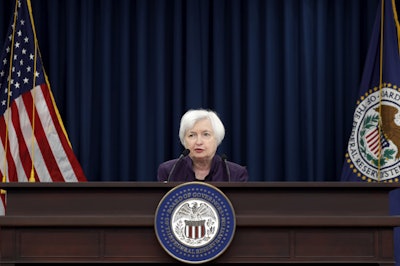
In the United States and around the world, economic strength isn't what it used to be. But everything is relative.
The Federal Reserve is set to raise short-term interest rates Wednesday for the third time in six months — a vote of confidence in the American economy and especially in the resilience of the U.S. job market.
Across the Atlantic, the European Central Bank is edging toward ending extraordinary steps to speed growth in the 19 countries that use the euro, a sign that an agonizing era of stagnation may be nearing an end.
And international agencies have lately issued upbeat reports on the global picture after persistent weakness in the years since the Great Recession.
Yet neither the U.S. nor the world economy is likely to regain the robust health that prevailed before the recession struck a decade ago.
"We certainly would expect slower growth than we had in the mid-2000s," says Sara Johnson, senior research director for IHS Markit.
The IMF foresees the global economy growing 3.5 percent this year — up from 3.1 percent in 2016 but well below the 4 to 5 percent growth typical of the mid-2000s.
A big problem is that the richest countries can't count on steadily growing workforces to drive expansion because their populations are aging. And across the globe, for reasons that largely confound economists, countries are struggling to generate the acceleration of worker productivity that normally underpins prosperity.
 The Federal Reserve is keeping its key interest rate unchanged but signaling that it will likely raise rates before year's end. (AP Photo/Alex Brandon)
The Federal Reserve is keeping its key interest rate unchanged but signaling that it will likely raise rates before year's end. (AP Photo/Alex Brandon)Still, for now, the outlook is at least encouraging.
Unemployment in the eurozone reached an eight-year low in April. China has managed to keep growth expanding at a solid if slower pace, so far defying those who had warned that the world's second-biggest economy was headed for a hard fall. China is a leading consumer of the world's natural resources. Its resilience helps explain why prices for commodities — from oil to copper — have stabilized after tumbling from 2014-2016 and slowing global growth.
In the United States, factories have expanded for nine straight months, rebounding from a slump caused by cuts in the energy industry and by a strong dollar, which made American goods costlier overseas. The stock market is surging on stronger corporate profits, brightening economic forecasts and hopes that President Donald Trump and the Republican Congress will cut taxes and regulations.
Some economists and market analysts worry that stock prices— which tend to rise when rates are low — have already climbed too high. In fact, Johnson at IHS Markit says she suspects that the Fed may be ratcheting up rates partly to take a little air out of a potential bubble in stock prices before it bursts.
The U.S. unemployment rate is at 4.3 percent, a 16-year low. Super-low unemployment is giving the Fed confidence to lift U.S. rates — gradually — even though inflation remains stubbornly below the Fed's 2 percent target.
Still, the American economy is hardly sizzling. Annual growth hasn't hit 3 percent for a full year since 2005. It inched ahead last year at a meager 1.6 percent. And economists say hiring can't remain healthy for long if consumer and business spending and investment don't pick up and accelerate the underlying economy. Most economists do expect U.S. growth to pick up this year after expanding at a dismal 1.2 percent annual pace from January through March.
The Trump administration insists it can lift growth above 3 percent a year by cutting taxes, slashing regulations and spending more on roads, bridges and other infrastructure projects. But most economists are skeptical — and not just because Trump's agenda has been delayed by political turmoil. Already, hiring has slowed. The economy added just 362,000 jobs from March through May — an average of 121,000 a month — the weakest three months of hiring since 2012.
One reason: With unemployment so low, "the U.S. is running out of people to hire," says Eric Lascelles, chief economist at RBC Global Asset Management.
And America's worker productivity growth is dismal, averaging just 1.2 percent a year since 2007 — half the annual gains registered from 2000 to 2007. Only when workers can generate more value per hour on the job do they generally accelerate economic growth and enjoy higher incomes.
Beyond the United States, analysts point to other reasons for concern.
Despite a relatively recent upbeat assessment, for instance, the World Bank calls the global economy "fragile." It warns of risks from rising trade protectionism, political conflict and possible financial fallout from the Fed's expected rate increases.
Sharper-than-expected rate hikes could, for example, rattle investors and drive up the value of the U.S. dollar as more investors pour money into the haven of Treasurys. A strong dollar would, in turn, hurt U.S. exporters. It would also squeeze foreign companies that borrowed in dollars and would have to put up steadily more money in their local currencies to repay their bills.
IHS Markit's Johnson says the world economy is enjoying a "cyclical pickup" this year. But she cautions:
"It will not match the gains of earlier periods."






















